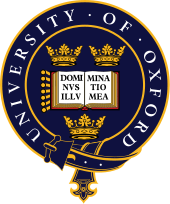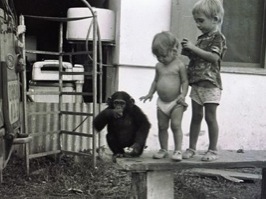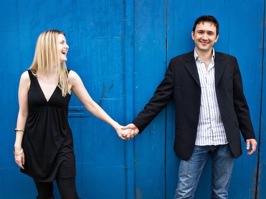 "Dominus Illuminatio Mea"
"Dominus Illuminatio Mea"
('the Lord is my light')Finding God At
OXFORD
 Dr. A.A. Louis, disappointed with string theory, on a long, lonely quest in search of the Holy Grail of theoretical physics, the unified theory of everything.How Dr. A. A. Louis Abandoned String Theory
Dr. A.A. Louis, disappointed with string theory, on a long, lonely quest in search of the Holy Grail of theoretical physics, the unified theory of everything.How Dr. A. A. Louis Abandoned String Theory
by Peter Clark, contributor to "Finding God at Harvard," international journalist and development consultant, and true friend of Ard and Mary's.
Progress in science is generally an incremental affair . . . a new insight here, a new proton, gluon, or duodenum there. Occasionally, however, a major “paradigm shift” in thinking occurs, (a phrase coined by Thomas Kuhn in “The Structure of Scientific Revolutions), that turns the science world on its head. One example of an early paradigm shift -- Copernicus rejected Ptolemaic cosmology when he posited that the earth revolved around the sun, and not vice-versa. Another such world changing paradigm shift has occurred thanks to the work of Dr. A. A. Louis, an unassuming, youthful-looking Oxford lecturer, who has abandoned string theory for a new unified theory of everything. This is the story of his intellectual journey.  Dr. Louis was raised in Gabon, West Africa. As a child, he developed an intense interest in science. His parents loved philosophy, literature, and botany, and he concentrated on species differentiation, tracking ecological, morphological, and genetic divergence between man, woman, and ape. Of course he observed the obvious differences - like hair color - but there were also certain curious similarities that led him to accept aspects of evolutionary theory - both woman and ape pulled hair.
Dr. Louis was raised in Gabon, West Africa. As a child, he developed an intense interest in science. His parents loved philosophy, literature, and botany, and he concentrated on species differentiation, tracking ecological, morphological, and genetic divergence between man, woman, and ape. Of course he observed the obvious differences - like hair color - but there were also certain curious similarities that led him to accept aspects of evolutionary theory - both woman and ape pulled hair.
Dr. Louis completed his undergraduate studies at the University of Utrecht in 1992, after writing a thesis on Entropic Phase Separation. A scripture passage in the introduction to his thesis gives evidence that young Dr. Louis was already strongly of the persuasion that there was a Creator who ordered a universe in a discoverable, systematic manner:
The Heavens declare the
glory of God;
the skies proclaim the work
of his hands.
Day after day they pour
forth speech;
night after night they
display knowledge.
There is no speech or
language
where their voice is not
heard.
Psalm 19:1-3
In 1992, Dr. Louis moved to Ithaca, New York to begin his doctoral work in physics at Cornell University, where I first met Dr. Louis. There was no evidence at the time of the genius within . . . perhaps because he was getting the “wild child” out of his system. This latent rebellion could be observed in his offbeat mismatched plaids and stripes, with cartoon character socks (Tweety Bird was a favorite). There is also little evidence that he spent much time on cosmology, though he did coincide from 1992 to 1996 with Dr. Brian Greene, one of the world’s best known string theorists, and author of the bestselling “The Elegant Universe: Superstrings, Hidden Dimensions, and the Quest for the Ultimate Theory.”
He set aside a search for a unified theory of everything while he focused on lesser details like atomic tunneling and the metallization of fluid hydrogen prior to achieving his Ph.D. from Cornell in 1998. Perhaps he just did not want to appear pretentious. Younger scientists also face challenges pursuing foundational questions as graduate students within academia. There is terrific pressure to publish in order to gain top-level professorial appointments upon graduation. Smaller breakthroughs make for quicker papers. Foundational papers take time.
However, I do recall Dr. Louis beginning to ask foundational questions during his Cornell period. He was puzzled by the phenomena of unexpected gravitational attractions between opposite celestial bodies, and questioned how and why this frequently affected him. Like King Solomon, he was mystified by “the way of an eagle in the sky, the way of a snake on a rock, the way of a ship on the high seas, and the way of a man with a maiden.” (Proverbs 30:19)
Perhaps these questions, and others like them, drove him to begin to search for a theory of everything, one unifying idea that aims to incorporate all of the universe’s forces into a single mathematical framework. The challenge was that theoretical physics seems to have two separate mathematical languages; one to describe general relativity, which explains behavior of large objects like stars, and the other for quantum mechanics, which precisely describes the phenomena of very small objects like particles, and the brain of the guy who cut me off in traffic yesterday.
Thus, there is still no coherent way to describe crossover phenomenon like horizons of black holes or transvestites. Basically, general relativity is from Mars, and quantum mechanics is from Venus.
After Cornell, Dr. Louis assumed a lectureship at Cambridge University which he has maintained until his recent move to Oxford University. This institutional change proved pivotal in Dr. Louis’ intellectual journey - his major breakthrough was not to occur until after he left Cambridge for Oxford. Both universities provided ample opportunity for research and reflection. Officially, Dr. Louis continued to publish papers on incremental questions, warning of density dependent pair potentials (2002), scandalously observing the phase separation of a multiple occupancy lattice gas (2004), and even tipping his hand that he was still interested in foundational questions when he asked if water was an amniotic Eden or a corrosive hell (2006).
We do know, however, that behind the scenes, Dr. Louis was dabbling in string theory, his preferred theory of everything at that stage of his intellectual journey. He desperately wanted to bridge the gap between general relativity and quantum physics. We know he was into string theory only by inference, but it is well-grounded inference based on multiple anecdotes and stories from friends and colleagues who interacted with Dr. Louis during this time.
String theory posits “everything” as an interlocking network of ten or eleven dimensions connected by tiny open and closed looped strings of electrons that vibrate. The problem is that we currently only “know” four dimensions, so “compactifications” are required to bring some of the phenomena from higher dimensions into the known four dimensions. Some of the math on the higher dimensions is beautiful and elegant, but these equations point to a number of possible solutions, yielding only general landscapes of possible universes. The theory also seems incomplete, because the electron vibrations are so fast that they are untestable . . . so, string theory remains a work in progress . . . offering insights, but falling short of total coherence.
Dr. Louis’ friends and colleagues attest that in the 1998 - 2007 timeframe, at times when you spoke to him, he was clearly solving equations in the fifth dimension or higher. His unfocused gaze would only snap to attention when you insisted he join you in a lower dimension. He would then pause and utter “yeah, yeah, yeah” . . . and proceed to compactify to a lower universe. The frequency of these sorts of reported interactions during this period provides overwhelming evidence that he was still attempting to make sense of his incomplete world, struggling to engage fully with reality in the lower four dimensions. He saw glimpses of elegance, of beauty, of simplicity, and coherence -- of truth -- but the glimpses were fleeting and ephemeral. Then, in the fall of 2007, at St. Aldgate’s Church in Oxford, Dr. Louis had a flash of insight that filled in the gaps, that threw string theory out on its ear, that became his new theory of everything. His discovery led to a total paradigm shift. He caught a new glimpse of someone he thought so intricate, so elegant, so beautiful, he assumed she must not exist for herself alone. He also thought, if I can see and feel that she is so beautiful, this insight, this thought I think, these feelings I feel must be true. This is the only thing that makes sense. The universe is beautiful, and simple, and elegant. She completes me and makes reality cohere. Her name was Mary.
Then, in the fall of 2007, at St. Aldgate’s Church in Oxford, Dr. Louis had a flash of insight that filled in the gaps, that threw string theory out on its ear, that became his new theory of everything. His discovery led to a total paradigm shift. He caught a new glimpse of someone he thought so intricate, so elegant, so beautiful, he assumed she must not exist for herself alone. He also thought, if I can see and feel that she is so beautiful, this insight, this thought I think, these feelings I feel must be true. This is the only thing that makes sense. The universe is beautiful, and simple, and elegant. She completes me and makes reality cohere. Her name was Mary.
Dr. Louis made his findings public at a presentation in New York City on September 20, 2008. The scientific community, parents and friends were present, toasting in hopes that this new theory of everything finds its full completion and proof to several additional generations.
Oxford Related:

